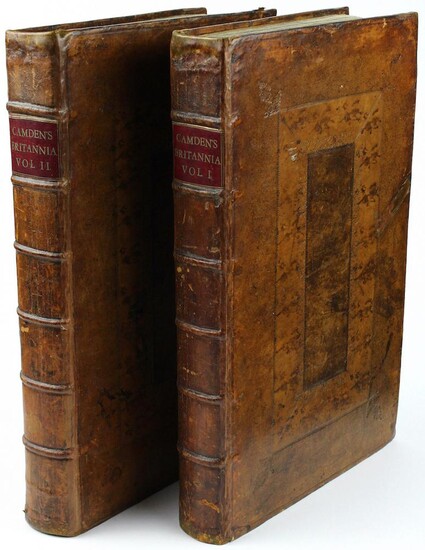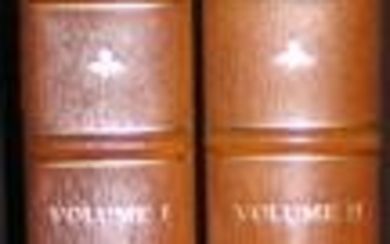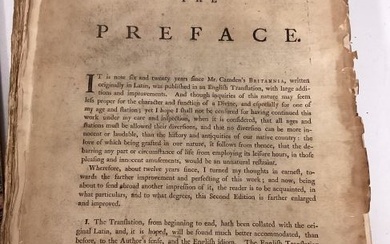Britannia: or a chorographical description of Great Britain and Ireland, together with the adjacent islands. Written in Latin by William Camden, Clarenceux, King at Arms: and translated into English, with additions and improvements. The second edition...
By CAMDEN, William (1551-1623)
A pinnacle of English scholarship, the first comprehensive topographical survey of Great Britain, complete in two tall folio volumes, mainly printed in two numbered columns: [66]pp,cclxviii columns,[2]pp,696 columns; [2],697-1526 columns,[176, appendices, index and errata]pp. Contemporary cambridge-style paneled calf (joints very neatly repaired), spine in seven compartments between raised bands, red morocco lettering pieces gilt; title pages in red and black, copper-engraved frontispiece portrait of Camden, 10 plates of coins and antiquities, 51 folding or double-page maps (including 42 county maps), additional engravings and woodcut illustrations in text. An unusually Fine set, original binding with handsome patina; pages bright, fresh and unmarked; plates and maps in deep, rich impressions. PMM 101 and Gibson's Library, p. 87 (for first edition). Challinor 2. Goldsmiths' 6088. ESTC Citation No. T144701. Second (and Best) Edition of this essential translation (by Edmund Gibson), the first successful transcription into English, with maps by Robert Morden. "Not a history, the Britannia attempts (in the words of Gibson's translation of Camden's preface) 'to restore Britain to Antiquity, and Antiquity to Britain'-the charge that Camden says was given him by the 'great Restorer of old Geography', [Abraham] Ortelius himself. It does so by documenting the ancient pre-Roman British past using every kind of primary historical evidence imaginable, whether written records, inscriptions, literary remains, material both historical and mythological, or testimony drawn from the physical landscape. In his use of non-literary evidence Camden was a leading figure in his generation, and his work in numismatics . . . has been described as 'of pioneering importance' (Piggott, 204). Recognizing the imperfection of the written record, particularly the scarcity of genuine British material, Camden looks to multiple kinds of evidence to push the record as far back as possible and to trace continuities through the different periods of British history." Britannia made its début, in Latin, on 2 May 1586, with enlarged editions following in 1587, 1590, 1594, 1600 and 1607, the final Latin edition in Camden's lifetime, published in folio and containing an index, maps by Saxton and Norden, and engravings of coins, monuments, and topographical sites-all in all, an impressive and editorially sophisticated work of scholarship. The first translation into English came in 1610 , at the hand of Philemon Holland . Yet despite Camden's collaboration, "the translation is often inaccurate and takes liberties with the material, and for this reason is regarded as inferior to Edmund Gibson's translation of 1695 (ours is the second, enlarged edition of that essential translation, published in 1722). Gibson was assisted in his efforts by numerous scholars, including Samuel Pepys, and his translation was held in high esteem for the better part of the 18th century until It was finally superseded in 1789 by the edition of Richard Gough. (Literary Encyclopedia) "If Camden was not the first English historian (in the modern sense of the word), topographer, and antiquarian, he was certainly the first to relate the three studies, and his Britannia, primarily topographical, is the first book which shows, even in a rudimentary form, the need to evaluate sources. It was the revolutionary subject matter, and its even more revolutionary treatment of the subject, which made it at once the vehicle and the model for research in all three subjects for the next two hundred and fifty years." (PMM).
Published by: printed by Mary Matthews, for Awnsham Churchill, and sold by William Taylor, in Pater-Noster-Row, London, 1722
Vendor: Fine Editions Ltd
Buy Now on
By CAMDEN, William (1551-1623)
A pinnacle of English scholarship, the first comprehensive topographical survey of Great Britain, complete in two tall folio volumes, mainly printed in two numbered columns: [66]pp,cclxviii columns,[2]pp,696 columns; [2],697-1526 columns,[176, appendices, index and errata]pp. Contemporary cambridge-style paneled calf (joints very neatly repaired), spine in seven compartments between raised bands, red morocco lettering pieces gilt; title pages in red and black, copper-engraved frontispiece portrait of Camden, 10 plates of coins and antiquities, 51 folding or double-page maps (including 42 county maps), additional engravings and woodcut illustrations in text. An unusually Fine set, original binding with handsome patina; pages bright, fresh and unmarked; plates and maps in deep, rich impressions. PMM 101 and Gibson's Library, p. 87 (for first edition). Challinor 2. Goldsmiths' 6088. ESTC Citation No. T144701. Second (and Best) Edition of this essential translation (by Edmund Gibson), the first successful transcription into English, with maps by Robert Morden. "Not a history, the Britannia attempts (in the words of Gibson's translation of Camden's preface) 'to restore Britain to Antiquity, and Antiquity to Britain'-the charge that Camden says was given him by the 'great Restorer of old Geography', [Abraham] Ortelius himself. It does so by documenting the ancient pre-Roman British past using every kind of primary historical evidence imaginable, whether written records, inscriptions, literary remains, material both historical and mythological, or testimony drawn from the physical landscape. In his use of non-literary evidence Camden was a leading figure in his generation, and his work in numismatics . . . has been described as 'of pioneering importance' (Piggott, 204). Recognizing the imperfection of the written record, particularly the scarcity of genuine British material, Camden looks to multiple kinds of evidence to push the record as far back as possible and to trace continuities through the different periods of British history." Britannia made its début, in Latin, on 2 May 1586, with enlarged editions following in 1587, 1590, 1594, 1600 and 1607, the final Latin edition in Camden's lifetime, published in folio and containing an index, maps by Saxton and Norden, and engravings of coins, monuments, and topographical sites-all in all, an impressive and editorially sophisticated work of scholarship. The first translation into English came in 1610 , at the hand of Philemon Holland . Yet despite Camden's collaboration, "the translation is often inaccurate and takes liberties with the material, and for this reason is regarded as inferior to Edmund Gibson's translation of 1695 (ours is the second, enlarged edition of that essential translation, published in 1722). Gibson was assisted in his efforts by numerous scholars, including Samuel Pepys, and his translation was held in high esteem for the better part of the 18th century until It was finally superseded in 1789 by the edition of Richard Gough. (Literary Encyclopedia) "If Camden was not the first English historian (in the modern sense of the word), topographer, and antiquarian, he was certainly the first to relate the three studies, and his Britannia, primarily topographical, is the first book which shows, even in a rudimentary form, the need to evaluate sources. It was the revolutionary subject matter, and its even more revolutionary treatment of the subject, which made it at once the vehicle and the model for research in all three subjects for the next two hundred and fifty years." (PMM).
Published by: printed by Mary Matthews, for Awnsham Churchill, and sold by William Taylor, in Pater-Noster-Row, London, 1722
Vendor: Fine Editions Ltd





